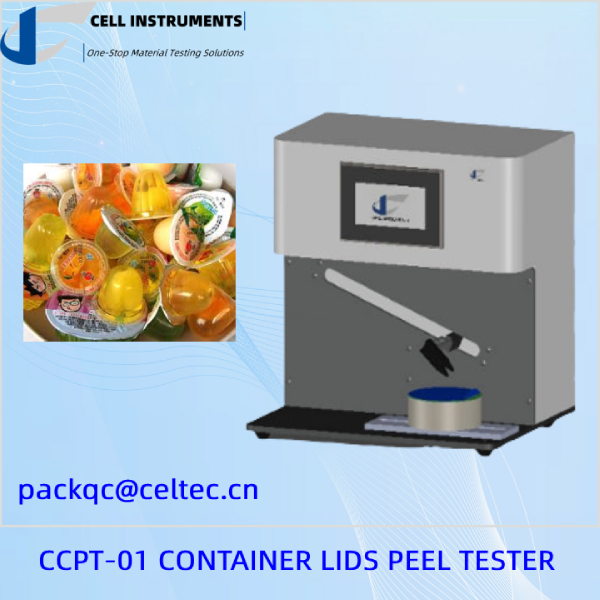How to Measure the Seal Strength of Peel Lids for Jelly Cups
Ensuring the seal strength of peel lids on jelly cups is crucial for maintaining product integrity and consumer safety. The seal strength of peel lids is a key factor in preventing contamination and preserving the quality of the product. This article will delve into the importance of testing the seal strength, the methodologies involved, and the benefits of using advanced testing instruments such as the Cell Instruments CCPT-01 Container Lids Peel Tester.
I. The Importance of Seal Strength in Peel Lids
The seal strength of peel lids is a measure of the force required to peel a lid from its container. In the context of jelly cups, a strong seal is essential to prevent leaks, contamination, and spoilage. Poor seal strength can lead to product recalls, brand damage, and potential health risks for consumers.
II. Jelly Cup Lid Seal Strength Testing: Understanding ASTM F2824
1. Overview of ASTM F2824
ASTM F2824 is the Standard Test Method for Mechanical Seal Strength Testing for Round Cups and Bowl Containers with Flexible Peelable Lids. This standard outlines the procedures for testing the mechanical seal strength of lids, ensuring consistency and reliability in the results.
2. Testing Procedures According to ASTM F2824
- Calibration and Setup: Begin by calibrating the force-measuring device to ensure accurate results. Secure the jelly cup in the test equipment fixture, aligning the starting peel point with the peel line.
- Peel Rate: Set the peel rate to 12 ± 0.5 in./min (300 ± 12.7 mm/min) as specified in ASTM F2824.
- Conducting the Test: Attach the lid’s peeling tab to the grip of the force-measuring device and initiate the test. The device will measure the force required to peel the lid from the container.
- Recording Results: After the test cycle is complete, record the maximum, minimum, and average forces. Repeat the procedure for additional samples to ensure consistency.
III. Key Considerations in Jelly Cup Lid Seal Strength Testing
1. Consistency and Reliability
Using standardized methods such as those outlined in ASTM F2824 ensures that the testing is consistent and reliable. This standardization is crucial for comparing results across different batches and ensuring compliance with industry regulations.
2. Equipment and Instrumentation
The choice of testing equipment plays a significant role in the accuracy of the results. The Cell Instruments CCPT-01 Container Lids Peel Tester is designed for high precision and accuracy in measuring the peel strength of container lids. Its user-friendly interface and customizable test parameters make it an ideal choice for various industries, including food, medical, and pharmaceutical.
IV. Benefits of Using the CCPT-01 Container Lids Peel Tester
1. High Precision and Accuracy
The CCPT-01 features a robust internal structure, stepping motor, and precision ball screw, ensuring good stability and accurate measurements. This high precision is crucial for obtaining reliable data on the seal strength of jelly cup lids.
2. User-Friendly Interface
Equipped with a PLC and an HMI color touchscreen, the CCPT-01 is easy to operate, even for users with minimal technical background. This ease of use enhances the efficiency of the testing process.
3. Customizable Test Parameters
The instrument allows for stepless speed regulation and offers both manual and automatic test initiation. Users can set stroke positions or specify fixed force values and holding times, making it versatile for different testing requirements.
4. Real-Time Data Recording and Analysis
The CCPT-01 provides real-time force curve display and automated calculation of maximum, minimum, and average forces. This feature enhances the efficiency and accuracy of data analysis, providing valuable insights into the seal strength of peel lids.
V. Ensuring Compliance and Quality Assurance
1. Importance of Compliance with ASTM F2824
Compliance with ASTM F2824 ensures that the testing methods meet industry standards, enhancing the credibility and reliability of the results. This compliance is essential for maintaining product quality and meeting regulatory requirements.
2. Role in Quality Assurance
Regular testing of the seal strength of peel lids using standardized methods helps in maintaining high product quality. It ensures that the packaging is secure, preventing leaks and contamination, and maintaining consumer trust.
VI. FAQs About Seal Strength Testing for Peel Lids
Seal strength testing ensures that the lid adheres securely to the container, preventing leaks, contamination, and spoilage. It is crucial for maintaining product quality and consumer safety.
ASTM F2824 provides a standardized method for testing the mechanical seal strength of peelable lids, ensuring consistency and comparability of results across different testing scenarios.
The CCPT-01 offers high precision, a user-friendly interface, customizable test parameters, and real-time data recording and analysis. These features make it an ideal choice for accurate and reliable seal strength testing.
Yes, the CCPT-01 can be tailored to meet specific testing requirements, including different container shapes, sizes, and materials. This customization ensures accurate and relevant test results.
Real-time data analysis provides immediate insights into the seal strength, enabling quick decision-making and adjustments to the packaging process. It enhances the efficiency and accuracy of quality assurance.

